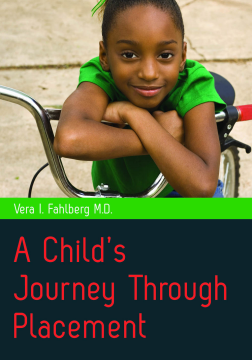
Additional Information
Book Details
Abstract
Children who are cared for in an out of home placement are in need of support and stability. This classic text offers information and advice for professionals and carers on how to help these children, who will often have attachment difficulties.
Vera I. Fahlberg, M.D. shares her experience and expertise, outlining the significance of attachment and separation, the developmental stages specific to adoptive children and providing guidance on minimizing the trauma of moves. The book also features practical advice on case planning, managing behavior and direct work with children, and throughout are case studies and exercises which provide opportunities for further learning.
A readable, compassionate and practical text, A Child’s Journey Through Placement provides the foundation, the resources, and the tools to help students, professionals, parents and others who care to support children on their journey through placement to adulthood.
…the book attempts to fill a gap in the child-welfare literature by making the child the primary focus of attention…the child's relationship to his or her primary caretaker is undergoing a major, if not radical, change…Fahlberg spends about one-third of the text discussing the development of the attachment between a child and a caregiver from infancy through to adolescence…Case studies, often related in an anecdotal form, are raised frequently as illustrations and guidelines.
The Small Press Book Review
Vera I. Fahlberg, M.D. is a retired pediatrician and psychotherapist. A trainer and consultant with an international reputation, she has travelled around the world sharing her expertise in attachment therapy with families and mental health professionals. For many years she was medical director at Forest Heights Lodge in Evergreen, Colorado, a residential treatment facility for troubled young boys. She has two grown up children and has fostered several children. She lives in Bremerton, Washington, USA.
Dr Fahlberg's insightful, empathetic, respectful, and nurturant stance toward the children, and toward the adults who are their guides on their journeys, enhance the value of her practical and action-orientated suggestions for minimizing trauma and dealing with the effects. The work is brought to life by stories of children going through their placement journeys.
Media Review
Parents who want to help children build healthy attachments and self-esteem to minimize the risks associated with complex placement experiences will find this an important addition to their resources.
Adoptive Families Magazine
…this book… contains such valuable information about the needs of children that it would prove beneficial to anyone – parent of professional – working with children regardless of whether these children are at risk for psychological problems or not.
Adopted Child
Table of Contents
| Section Title | Page | Action | Price |
|---|---|---|---|
| A Child’s Journey Through Placement | 1 | ||
| Introduction | 8 | ||
| Chapter One: Attachment and Bonding | 16 | ||
| Section I: The Importance of Attachment | 18 | ||
| Section II: The Development of Attachment between Parent\rand Child | 24 | ||
| Section III: Assessing Attachment | 36 | ||
| Section IV: Identifying Attachment Problems | 46 | ||
| Section V: Promoting New Attachments for Children in Care | 52 | ||
| Chapter Two: Child Development | 64 | ||
| Section I: The First Year of Life | 66 | ||
| Section II: The Toddler Years | 72 | ||
| Section III: The Preschool Years | 79 | ||
| Section IV: The Ages Six through Ten | 96 | ||
| Section V: Adolescence | 105 | ||
| Section VI: Special Developmental Issues | 118 | ||
| Chapter Three: Separation and Loss | 138 | ||
| Section I: Factors Influencing the Reaction to Separation | 140 | ||
| Section II: The Grief Process | 161 | ||
| Section III: How Unresolved Separations May Interfere with New\rAttachments | 168 | ||
| Chapter Four: Minimizing the Trauma of Moves | 172 | ||
| Section I: Overall Strategies for Minimizing the Trauma of Moves | 174 | ||
| Section II: When Children Enter Interim Care | 182 | ||
| Section III: The Foster Family’s Role When the Child Leaves their\rHome | 196 | ||
| Section IV: Return to the Birth Parents | 202 | ||
| Section V: Moving a Child to Adoption | 205 | ||
| Section VI: Leaving the System by Emancipation | 228 | ||
| Chapter Five: Case Planning | 232 | ||
| Section I: Working with Birth Parents | 234 | ||
| Section II: Assessment | 238 | ||
| Section III: Treatment Planning | 253 | ||
| Section IV: Special Issues | 266 | ||
| Chapter Six: Behavior Problems | 282 | ||
| Section I: Principles of Behavior Management | 284 | ||
| Section II: Selecting an Approach to Behavior Management | 294 | ||
| Section III: Managin Behavior that Reflects Attachment Problems | 308 | ||
| Section IV: Children with Learning Problems | 322 | ||
| Chapter Seven: Direct Work with Children | 334 | ||
| Section I: The Scope of Direct Work | 336 | ||
| Section II: Communicating with Children | 350 | ||
| Section III: Additional Communication Tools | 353 | ||
| Section IV: The Lifebook | 364 | ||
| Postscript | 388 | ||
| Glossary | 392 | ||
| Bibliography by Chapter | 394 | ||
| Bibliography | 408 | ||
| Index | 420 | ||
| Blank Page | c |
